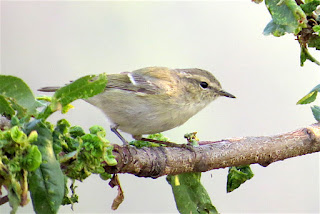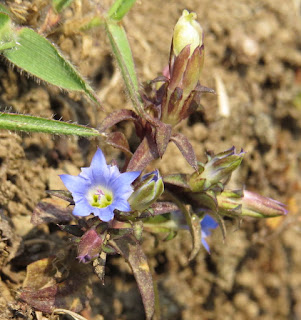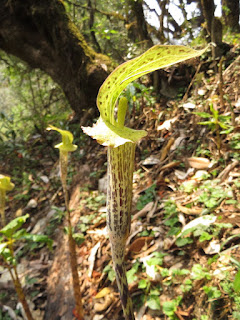It turns out
that one of the main draws to doing a trek in Nepal is the scenery. If you look
up once in a while, you should see a different angle on a most abrupt spine of
snow-covered peaks that jut up to over 8000 meters (26,500 feet) in elevation.
Crazy people climb them, but most people are happy to just see them. Our guide
Resham chose this particular hotel for the fine views of Annapurna South (the
10th highest mountain in the world), and this is the view I had just
before sunrise.
That would
end up being the clearest, sharpest view anyone would have of the mountains for
weeks. One guy we met suggested that regional humidity and evaporation from the
snow fields during these hot days has created the haze. But the haze is in all
directions, all over the country. And it’s brownish, obvious in the morning sun
or the scarlet moon. There are little and big brush, grass, and garbage fires
everywhere in Nepal and India, nothing to stop them, and no rain for weeks to
wash the skies. And the air is in fact quite dry, dew disappearing very early
in the day. Thank goodness the views of the mountains aren’t my primary reason
for doing the trek as it is for so many others, otherwise it would be a near
bust. The habitat is amazing, the forests and streams are gorgeous, the
exercise is exhilarating, and it’s fun to meet all the other travelers. And of
course there are birds, and today we trek through some beautiful habitat from
Ulleri to Ghorepani.
We had a
relaxed start, coffee in the garden overlooking small fields of wheat and other
vegetables, with some scattered trees. The ravine next to the hotel has a small
patch of woods from which some Mountain Bulbuls occasionally sang. One of the
better birds here was a male Pied Thrush that flew out and sang from an exposed
alder tree below the hotel, but it always perched right behind a branch, avoiding
having its photo taken. Somehow I managed a photo of this flitty thing in the
apple tree, apparently a Hume's Warbler. These Phylloscopus warblers are as bad as our American Empidonax flycatchers, but worse – they
never sit still.
This is Metapora agathon, the Great Blackvein, a
member of the white family.
This Gentiana species was very common on the
dirt and rock banks created by the terraced farming, but at just a few millimeters
across, it went unnoticed by most hikers.
This is how
all the more serious trekkers get their camping gear up these trails.
Televisions, refrigerators, and all that beer comes up the same way. I stopped
feeling sorry for our porter Ananta when we saw the loads that so many porters
carry miles and miles up these steep mountains.
Gray Wagtail
breeds here and there in the open farmland, not necessarily on flowing streams
like in other areas.
After a
kilometer or so through many small farms, we entered some gorgeous forest.
Several oak species are among the dominant trees. As you can see, it's hazy everywhere.
I lagged
behind a lot, as there were so many possible new birds for me in this region,
and I know virtually none of their voices. I ended up with thirteen lifers
today. A singing and very recalcitrant Indian
Blue Robin took a lot of time to see and figure out. This Black-eared
Shrike-babbler was much more cooperative but still very active; I spent a lot of time trying to get
photos – totally worth it, my favorite bird of the day by far. The shrike-babblers were once considered babblers,
but that family has now been split up into several families, some of them quite
distant from the others, phylogenetically speaking. Perhaps most distant are
the shrike-babblers which turn out to be more closely related to the New World
vireos, and they are currently placed in that family. They are actually quite
reminiscent of the shrike-vireos in their striking colors, behavior, and song.
This is a
Hoary-throated Barwing, a member of the laughingthrush family, another of
the former split-up babbler family.
As we got
higher, rhododendrons started dominating the forest.
I was
puzzled by my first Rufous-gorgeted Flycatcher, a female. I then later found
this male, and then another, and another. It’s one of commoner, if not very
conspicuous members of the avifauna here.
This “cobra-lily”
was common in places; it appears to be Arisaema
nepenthoides, the specific epithet indicating that it closely resembles the
unrelated insectivorous plants in the genus Nepethes.
We passed
through a couple of small communities with small farms, hotels, and
restaurants. This is where I saw my lifer Lammergeier.
A Eurasian
Kestrel was hunting in one of these open areas too.
This is Childrena childreni, the Large
Silverstripe. It’s related to what we call fritillaries.
We passed
through the town called Lower Ghorepani before another long series of steps.
Then we were
in our final destination, Upper Ghorepani. Andrew waded through these mules to
get to our hotel.
We hiked
9.45 kilometers (5.9 miles) and gained 800 meters (2625 feet), arriving at an
elevation of 2900 meters (9514 feet).
But we
weren’t quite done. After a nap and relaxing time in our hotel (which again was
supposed to offer a stunning view of the mountains), Resham took us on the
steep climb up to Poon Hill. On the way I stopped for birds – a Collared
Owlet was tooting from a tree while holding a small rodent in its talons and
being harassed by an Ashy-throated Warbler. Another mixed flock had this
Chestnut-tailed Minla, apparently carrying food to a nest. Minlas are former
babblers, now with the laughingthrushes.
The trail
goes up and up – over 340 meters in 1.6 kilometers (1115 feet in a mile).
It reminds
me of my favorite Marys Peak in Oregon’s Coast Range, with a ring of fir forest
and rhododendron shrubs and small meadows around the peak. Different birds are
here too – I managed to see Coal
Tit and Grayish-flanked Bush-Warbler in the dwindling daylight.
We could
just barely see Annapurna South from here, supposedly one of the more
spectacular vistas of the Annapurna massif when it’s clear. We were the only ones here and enjoyed a
delightful whiskey on the benches until after sunset. We were grateful for Resham’s suggestion to avoid the pre-dawn crowds
that gather for sunrise. That’s another one of those things you do here; don’t
ask questions.
Not far down
the steps as it was getting quite dark, we heard a distinctive two-noted owl hooting from the scattered fir
trees. Looking through my field guide (a 16-year-old edition of Birds of Nepal)
I decided the only option in this habitat was Tawny Owl, except this sounded like no Tawny Owl.
Indeed, I later found that it has long been split and is now called Himalayan
Owl. I got the following recording.





























No comments:
Post a Comment